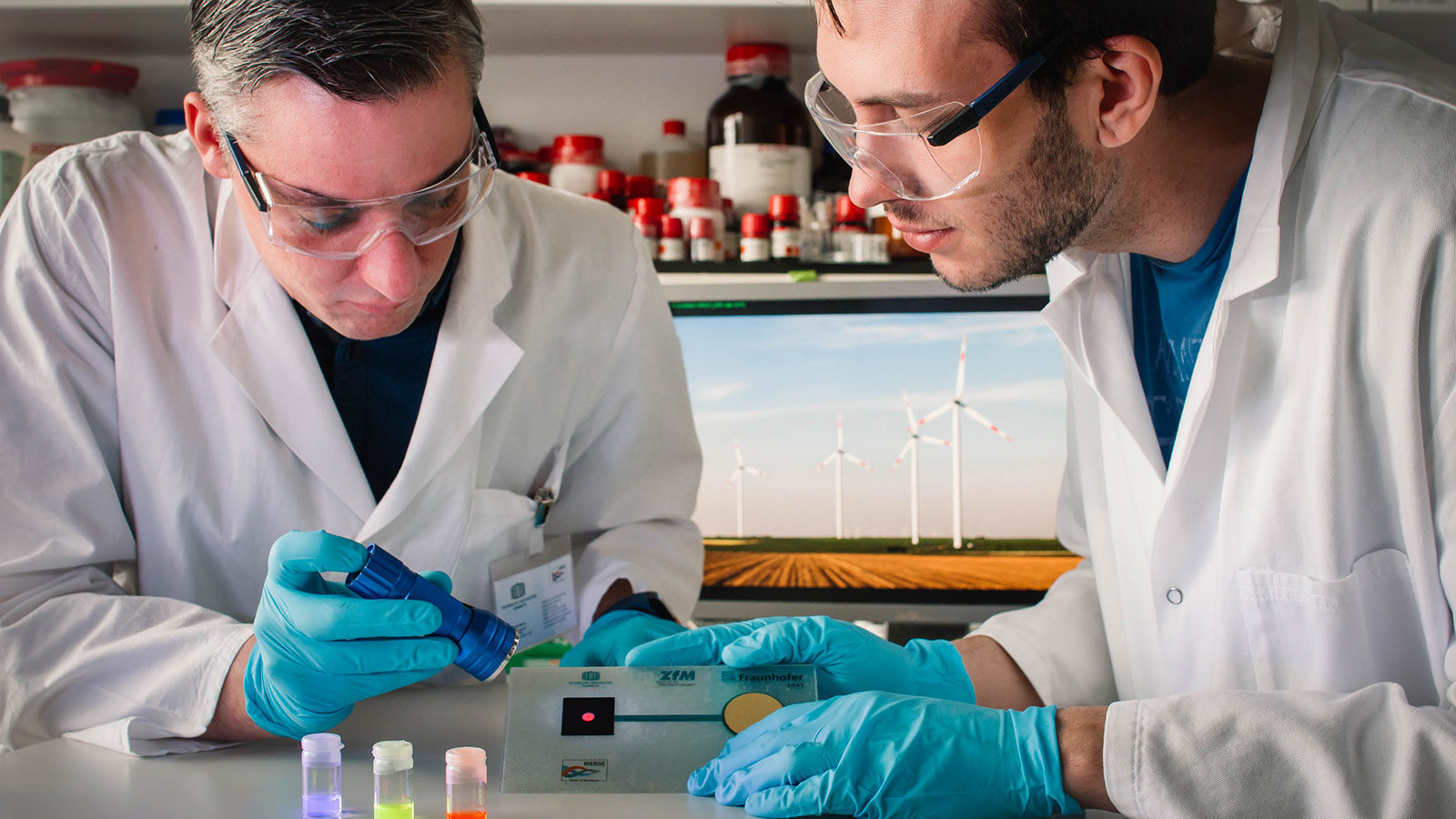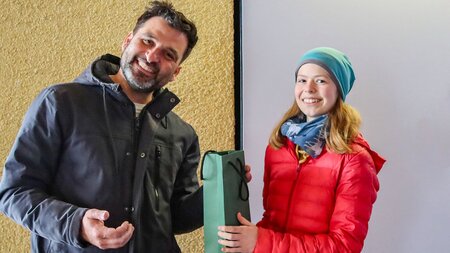Premiere at the Hanover Fair: clever films full of quantum dots
Wind turbines, vehicles or bicycle helmets can become safer: thin-film sensors for visualization of critical mechanical stresses
-

Martin Möbius (l.) and Jörn Langenickel of the Center for Microtechnologies at the Chemnitz University demonstrate the fluorescent effect of the film-based sensor with embedded Quantum Dots (QD) that have been integrated into a fiber-reinforced composite. If the composites are mechanically stressed, charge carriers are generated by a piezoelectric layer which, in turn, reduces the fluorescent effect of the quantum dots. The thin-film sensor can, for example, be integrated into rotor blades of wind turbines. Photo: Conny Schubert
A severe storm is gathering and the rotor blades of a wind turbine will be exceedingly stressed. Microscopic damages within the fiber-reinforced plastic can occur that often remain undetected. This results in the decrease of stiffness and strength and can, in the worst case, lead to heavy bending or even breaking of the rotor blades during the next storm. Scientists of the Center for Microtechnologies at the Chemnitz University of Technology and the Fraunhofer Institute for Electronic Nano Systems ENAS developed in the framework of the Federal Cluster of Excellence MERGE a multilayer sensor film coated with fluorescent nanoparticles. If this sensor film is, for example, embedded into the surface of the rotor blades timely discoveries of potential damage can be detected during the routine maintenance of wind turbines. Why? Because the sensor film changes its brightness of photoluminescence during stress and stores the information for a certain amount of time. This safety measure would also make sense in the wheel suspension of vehicles or lightweight components. Also in bicycle or motorcycle helmets users could gain feedback about the condition of their head protection.
This is made possible by the usage of tiny semiconductor nanocrystals. They offer an excellent utilization as nanosensors due to their sensitivity in regard to electric fields and charges. “We developed a new system for the visualization of mechanical stress based on quantum dots”, illustrates Dr. Jörg Martin of the Fraunhofer Institute ENAS. The centerpiece is the combination of piezoelectric elements with a so-called QD-composite-layer, converting mechanical stress into a locally reduced photoluminescence of the particles. Thus, sudden stress – for example on a rotor blade – is clearly visible as visual contrast. “The nano sensors do not need any energy supply for themselves”, says Martin Möbius of the Center for Microtechnology at the Chemnitz University. Therefore, an energy self-sufficient monitoring of large surfaces or composites with almost any desired shape is possible and critical stress levels – in lightweight composites in particular – can be detected in the course of routine maintenances.
“One of the major challenges of this development is the functional integration of the sensor layers in lightweight composites by means of laminating,”, Dr. Martin adds. But especially the integration of additional functionality offers a huge application potential which is why further solution approaches are investigated and applied together with other researchers within the Federal Cluster of Excellence MERGE.
The Chemnitz researchers will present their “clever film” and new sensor concepts for the first time on the Hanover Fair from April 24 till 28, 2017. They will be at the booth of the Fraunhofer Institute ENAS, at the joint booth of the IVAM Association for Microtechnology (Hall 6, Booth C30).
Further information is available from Martin Möbius, phone +49 371 531 39461, e-mail martin.moebius@zfm.tu-chemnitz.de and Dr. Jörg Martin, phone +49 371 45001 244, e-mail joerg.martin@enas.fraunhofer.de.
Matthias Fejes
05.04.2017





